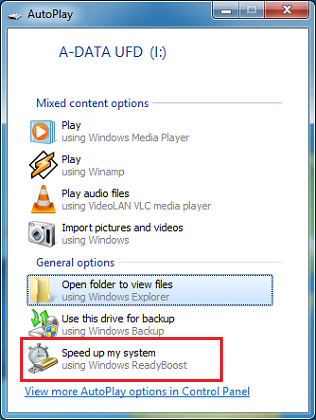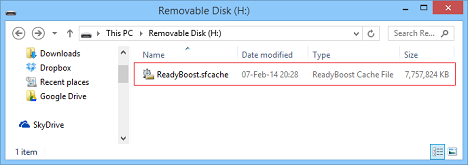

It is simply because of how SSDs extract data.

That is not because SSDs are so much faster. So, for example, if you regularly fire up Chrome every morning around 9 AM, SysMain, having predicted your next step will begin preloading some of Chrome's files and Prefetch will determine which files to load first once you click on Chrome's icon.Īs Gorstak correctly noted, these services are automatically disabled for SSDs. SysMain and Prefetch, while separate features, can work together.
#WHAT IS READYBOOST CACHE WINDOWS#
This would be great for large applications like Microsoft Word or your security programs where multiple large files are loaded each time Word or Windows starts.

It is used to optimize the loading time of an application the very next time you run it. Prefetch, on the other hand, is more a "tactical" tool for "immediate" impact. Because it needs to see and learn a user's computing habits and daily routines in order to determine and learn how a user uses their computer, it can take a few days before it becomes most effective. Superfetch/SysMain is a "strategic" tool - that is, it works "over time" to learn how a user uses his or her computer throughout the day to improve performance based on how that user uses the computer - to include the time of day they typically do specific tasks. It is, however, the new name for Superfetch. Superfetch and Prefetch are two separate features. ReadyBoost behaves more like a cache in that the data is "preloaded" into a flash drive (or similar device) much like priority data is stuffed into a page file. Prefetch will actually re-arrange data on a hard disk so it loads faster. ReadyBoost uses Superfetch, but is not the same as Prefetch.

Subscribe to techpowerup and like it on social media Basically, you can control who manages these caches, windows, bios or nobody. It will use 2nd level cpu to speed up your OS, and it will use 3rd level cache to help all other caches work as a unit. Or, if the cpu has a igpu, it will use 4th level cache to speed it up. It can use 1st level cache to speed up cpu tasks, which will show in cpu benches. So what does all of this mean? Basically, cpu is already fast, it uses cache to speed up the rest of your system. This is all other devices cache, like for example your network card. Slowest of all caches, but shared amongst them all. It basically increases the size of RAM available to kernel and loads it all up. Large cache is used on workstations and servers if second level cache is enabled. This is basically the windows core, and in my registry, managing caching of windows core is disabled, meaning bios will do it. This value does not exist in my registry, meaning windows doesn't manage it. I came across some articles as first google results, that should really be burried somewhere very, very deep:įirst level cache is cpu cache. I have noticed recently that there is some unused caching in registry portion of windows memory management, and done some digging. This basically means, if you want to run superfetch and prefetch regardless of what drive you use, you set their dword values to 1. Now, who ever tells you something else, is either lying through their teeth or uneducated or an idiot! You start it yourself when you feel like it.
#WHAT IS READYBOOST CACHE MANUAL#
It will start after bootup process is finishedģ = three means manual start. It will boot asap.Ģ = two means automatic delayed start. It wont start with pcġ = one means automatic start. Prefetch and superfetch registry keys are set to 3, which brings me to second part:Ġ = zero means disabled. Superfetch portion of it no longer takes up all of RAM and, I'm guessing here, but I think that instead of large short term improvement in performance, they opted for small increase with time. If user has an ssd, it wont run, and if user has hdd, it will. It's a single service that is supposed to figure out on which kind of drive superfetch and prefetch will run. This is, amongst other things, a new name for prefetch and superfetch. The idea is to be smart and release the used memory for caching when you run an app. It is supposed to use all available RAM for caching and try to anticipate what the user will do next. Ready boost is basically the same as prefetch, except it uses an external drive for storage, like your usb pendrive. The idea is to monitor the stuff you run often and speed them up. It stores frequently used stuff in a specific folder on a disk. Some of you may have noticed these services are missing in new windows build, and I've done some digging, so let me clarify.īasically, prefetch is windows idea of a RAM disk.


 0 kommentar(er)
0 kommentar(er)
